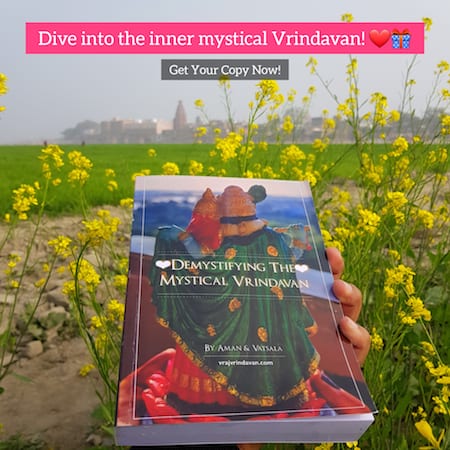Srimad Bhagavatam, originally written by Vyasdeva, was spoken by Sukadev Goswami to Parikshit Maharaj (Son of Abhimanyu and grandson of Arjuna and Pandavas) after Parikshit Maharaj had got a curse to die after 7 days.
There are 18 thousand verses spread over 12 cantos of Srimad Bhagavatam. It is non-different from Krishna and Srila Prabhupada mentions that Bhagavatam is the literary incarnation of Sri Krishna.
Ripened Fruit of Prema (Love)
Sukhdev Goswami is no ordinary saint but is actually Shuka, the pet parrot of Srimati Radharani in Nitya-Goloka Vrindavan. He sees the inner confidential lilas of Radha and Krishna and hence is the right person to teach Bhagavatam to the world. He is the son of Vyasdeva, the original writer of Srimad Bhagavatam.
Since the parrot likes to relish seeds of a fruit, Srimad Bhagavatam spoken by Sukadev Goswami is also called as the ripened fruit of prema (love).
All sins and conditioning get washed away simply by reading the Srimad Bhagavatam.
Wherever there is Srimad Bhagavatam recitation or narration going on, there is prosperity and well being.
Authentic Version of Bhagavatam
AC Bhaktivedanta Swami Srila Prabhupada has written an authentic bonafide English commentary of Srimad Bhagavatam that is in line with authentic Brahma Madhava Gaudiya Sampradaya.
You can download the FREE Srimad Bhagavatam PDF below.

The book 'Demystifying The Mystical Vrindavan' is the essence and crux of this entire website.
If you are considering to dive into the final goal of our Vedic Scriptures and spiritual life, and if Radharani inspires you, do get a copy of the book .
Real Identity of Srimad Bhagavatam & Review
The twelve cantos of Bhagavatam represent different parts of Krishna.
- 1st canto: Lotus Feet of Sri Krishna
- 2nd canto: Lotus Feet of Sri Krishna
- 3rd canto: Legs and Thighs
- 4th canto: Legs and Thighs
- 5th canto: Waist
- 6th canto: Chest
- 7th canto: Hands
- 8th canto: Shoulders
- 9th canto: Neck
- 10th canto: Krishna's smiling face
- 11th canto: Hair
- 12th canto: Ornaments on top of the head (peacock feather, crown)
One should respectfully approach Srimad Bhagavatam by reading the first two cantos which are the lotus feet of Sri Krishna. The eternal position of Krishna is described in there with all His avatars description. It helps one appreciate and develop respect for Krishna by knowing His full feature as the Supreme Personality of Godhead.
The very first text of Srimad Bhagavatam begins with om namoh bhagvate vasudevaya that means that Vyasdeva is offering obeisances to the Supreme Personality of Godhead Sri Krishna. This is in the same pattern as Chanakya Niti, Rig Veda or any other Vedic Scriptures where the writer (exalted saint) is first offering respect and taking blessings of Supreme Lord Sri Krishna.
Where is Radharani in Bhagavatam?
Check Why Srimati Radharani's name is not mentioned in Srimad Bhagavatam?
Predictions for Kali Yuga
There are various predictions made for Kali Yuga in twelfth canto of Srimad Bhagavatam.
In Srimad Bhagavatam 12.2.1-12.2.11, there are very difficult times stated for Kali Yuga. Some of them being that men and women would be together just for the sake of physical attraction, the businesses would be all about lies, there would be touch climatic conditions and hypocrisy and quarrel all around.
However, in verse 12.3.51 it is also mentioned that Kali Yuga is simplest to achieve liberation or develop the love for Godhead by easily chanting Hare Krisha Mahamantra. The same is repeated in 3rd Canto, 15th chapter, 25th verse where it is said that in this age of hypocrisy and quarrel, the best way to attain highest spiritual realisation is chanting Hare Krishna Hare Krishna | Krishna Krishna Hare Hare | Hare Rama Hare Rama | Rama Rama Hare Hare.
Download Free PDF of Srimad Bhagavatam
Srimad Bhagavatam (Original Unedited Edition by Srila Prabhupada; Printed between 1972-1980):
Canto 1:
Volume I (1972)
Volume II (1972)
Volume III (1972)
Canto 2:
Volume I (1972)
Volume II (1972)
Canto 3:
Volume I (1972)
Volume II (1974)
Volume III (1974)
Volume IV (1974)
Canto 4:
Volume I (1972)
Volume II (1972)
Volume III (1972)
Volume IV (1972)
Canto 5:
Volume I (1975)
Volume II (1975)
Canto 6:
Volume I (1975)
Volume II (1975)
Volume III (1976)
Canto 7:
Volume I (1976)
Volume II (1976)
Volume III (1976)
Canto 8:
Volume I (1976)
Volume II (1976)
Volume III (1976)
Canto 9:
Volume I (1977)
Volume II (1977)
Volume III (1977)
Canto 10:
Volume I (1977)
Volume II (1977)
Volume III (1980)
Alternatively, you can read the Srimad Bhagavatam online here.
Jai Jai Shri Radhe!
Hare Krishna!
